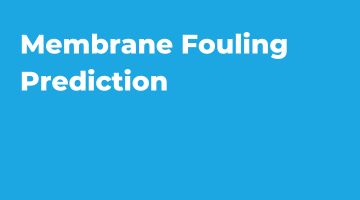Membrane Fouling Prediction

Ever since the introduction of the membrane industry in the 1970s, membrane fouling has been an inevitable phenomenon in membrane operations that severely affects the plant’s performance and costs. Predicting fouling in RO systems would allow diagnostic and preventive measures to be undertaken, which would rapidly limit the effects of fouling. The tactics developed to predict membrane fouling can take several forms, including:
- Plant Evaluation
- Usage of Fouling Indices
- Usage of Predictive Models
Plant Evaluation
Plant studies involve the design of an optimal system based on the characteristics of the feed. Information obtained from the analysis of the proposed water source is used to develop a pretreatment scheme for the feed water, evaluate the compatibility of one or more types of membranes with the feed water, as well as determine the optimal operating conditions.
Pilot plant tests are run for long hours (around several thousand hours) to gauge the performance of the membrane system. Although this method generally provides reasonably good predictability of membrane fouling, it is extremely costly and time-consuming.
Usage of Fouling Indices
Membrane fouling indices are predictive quantifiers that indicate how susceptible membranes are to fouling. The traditional and most widely applied fouling indices in RO systems are the silt density index (SDI) and the modified fouling index (MFI); however, these indices have several limitations, such as inadequate fouling prediction with small foulant agents, and neglecting cake-sustained osmotic pressure effects, as many of these fouling indices were developed before the recognition of such effects. Therefore, current research efforts have been devoted to improving the reliability and accuracy of these indices in predicting fouling-propensity. The following sections present the most commonly used fouling indices.
Usage of Predictive Models
Another approach for fouling prediction in membrane systems involves using mathematical prediction models. These mathematical models are valuable because they facilitate the optimization of fouling removal and prevention methods, and also help establish interactions and relationships between different filtration variables. Most equations aim at relating the time-dependent decline of the;
- Permeability
- Salt Rejection and
- Normalized Permeate Flow
These variables are used to determine the condition of the membrane in water treatment plants, the decline in the values tend to depict the possibility of decline in RO Membrane performance.
Business Benefits of RO Fouling Prediction
- Membrane Cost Benefit – Buy when you actually need it.
- Planned Maintenance
Conclusion
RO membrane processes are attractive technologies that have been widely used in desalination. A major challenge to this technology is membrane fouling. Membrane fouling depends on several factors including, the type of membrane material and membrane surface characteristics. This blog presented an overview of the different kinds of membrane fouling, the factors influencing fouling-propensity, tactics for the prediction of membrane fouling aimed at controlling and managing fouling occurrences.
